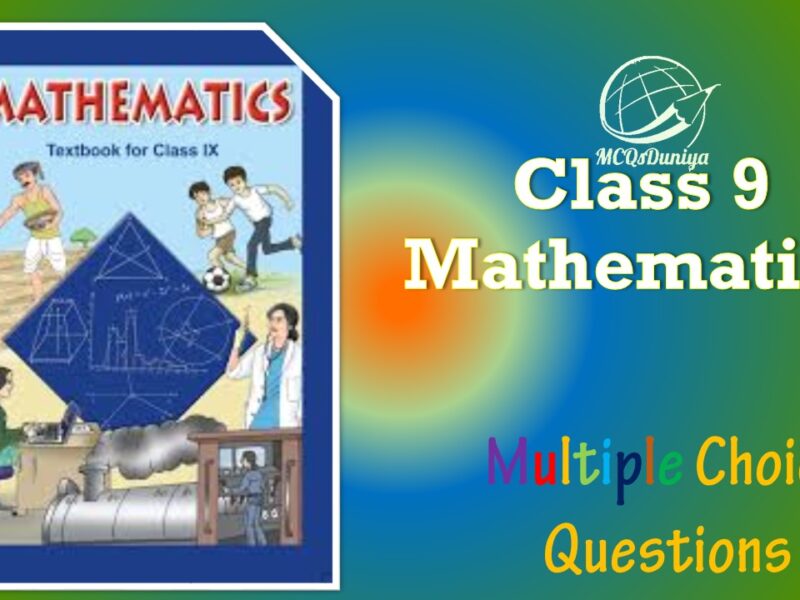CBSE Class 11 Mathematics Chapter 16 Probability Multiple Choice Questions with Answers. MCQ Class 11 Mathematics Probability with Answers was Prepared Based on Latest Exam Pattern. Students can solve NCERT Class 11 Mathematics Probability MCQs with Answers to know their preparation level.
Students who are searching for NCERT MCQ Questions for Class 11 Mathematics Probability with Answers are compiled here to get good practice on all fundamentals. Know your preparation level on MCQ Questions for Class 11 Mathematics with Answers. You can also verify your answers from our provided MCQ Class 11 Mathematics Probability with Answers. So, ace up your preparation with MCQ of Chapter 16 Mathematics Objective Questions.
MCQ Class 11 Mathematics Probability with Answers - Set - 1
Question 1:
The probability that in a random arrangement of the letters of the word INSTITUTION the three T are together is
(a) 0.554
(b) 0.0554
(c) 0.545
(d) 0.0545
Correct Answer – (D)
Given word: INSTITUTION
Total letters = 11
The word contains 3 I, 2 N, 1 S, 3 T, 1 U and 1 O
Total number of arrangement = 11!/(3!×2!×3!) = 554400
Now, taken 3 T are together.
So total latter = 9
The number of favorable cases = 9!/(3!×2!) = 30240
Now, P(3 T are together) = 30240/554400 = 0.0545
Question 2 :
The probability that when a hand of 7 cards is drawn from a well-shuffled deck of 52 cards, it contains 3 Kings is
(a) 1/221
(b) 5/716
(c) 9/1547
(d) None of these
Correct Answer – (C)
Total number of cards = 52
Number of king card = 4
Now, 7 cards are drawn from 52 cards.
P (3 cards are king) = {4C3 × 48C4}/52C7
= {4×(48×47×46×45)/(4×3×2×1)}/{(52×51×50×49×48×47×46)/(7×6×5×4×3×2×1)}
= {4×(48×47×46×45)×(7×6×5×4×3×2×1)}/{(4×3×2×1)×{(52×51×50×49×48×47×46)}
= (7×6×5×4×45)/(52×51×50×49)
= (6×5×4×45)/(52×51×50×7)
= (6×4×45)/(7×52×51×10)
= (6×45)/(7×13×51×10)
= (6×3)/(7×13×17×2)
= (3×3)/(7×13×17)
= 9/1547
Question 3 :
Two dice are thrown the events A, B, C are as follows A: Getting an odd number on the first die. B: Getting a total of 7 on the two dice. C: Getting a total of greater than or equal to 8 on the two dice. Then AUB is equal to
(a) 15
(b) 17
(c) 19
(d) 21
Correct Answer – (D)
When two dice are thrown, then total outcome = 6×6 = 36
A: Getting an odd number on the first die.
A = {(1, 1), (1, 2), (1, 3), (1, 4),(1, 5), (1, 6), (3, 1), (3, 2), (3, 3), (3, 4),(3, 5), (3, 6), (5, 1), (5, 2), (5, 3), (5, 4),(5, 5), (5, 6)}
Total outcome = 18
B: Getting a total of 7 on the two dice.
B = {(1, 6), (2, 5), (3, 4), (4, 3), (5, 2), (6, 1)}
Total outcome = 6
C: Getting a total of greater than or equal to 8 on the two dice.
C = {(2, 6), (3, 5), (3, 6), (4, 4),(4, 5), (4, 6), (5, 3), (5, 4), (5, 5), (5, 6),(6, 2), (6, 3), (6, 4), (6, 5), (6, 6)}
Total outcome = 15
Now n(A ∪ B) = n(A) + n(B) – n(A ∩ B)
⇒ n(A ∪ B) = 18 + 6 – 3
⇒ n(A ∪ B) = 21
Question 4 :
There are four machines and it is known that exactly two of them are faulty. They are tested, one by one, in a random order till both the faulty machines are identified. Then the probability that only two tests are needed is
(a) 1/3
(b) 1/6
(c) 1/2
(d) 1/4
Correct Answer – (B)
First, we choose 1 machine out of given 4.
The probability that it is fault = 2/4 = 1/2
Now, we have to pick the second fault machine.
The probability that it is fault = 1/3
So, required probability = (1/2)×(1/3) = 1/6
Question 5 :
If four whole numbers taken at random are multiplied together, then the chance that the last digit in the product is 1, 3, 5, 7 is
(a) 16/25
(b) 16/125
(c) 16/625
(d) none of these
Correct Answer – (C)
The last digit of the four whole number can be
0, 1, 2, 3, 4, 5, 6, 7, 8, 9
The chance that any of the four numbers is divisible by 2 or 5 = 6/10 = 3/5
Hence, the chance that any of the four numbers is not divisible by 2 or 5 = 1 – 3/5 = 2/5
So, the chance that all of the four numbers are divisible by 2 or 5 = (2/5)×(2/5)×(2/5)×(2/5)
= 16/625
This is the chance that the last digit in the product will not be 0, 2, 4, 5, 6, 8 and this is also the chance that the last digit in the product is 1, 3, 7 or 9
MCQ Class 11 Mathematics Probability with Answers
Question 6 :
A certain company sells tractors which fail at a rate of 1 out of 1000. If 500 tractors are purchased from this company, what is the probability of 2 of them failing within first year
(a) e-1/2/2
(b) e-1/2/4
(c) e-1/2/8
(d) none of these
Correct Answer – (C)
This question is based on Poisson distribution.
Now, λ = np = 500×(1/1000) = 500/1000 = 1/2
Now, P(x = 2) = {e-1/2 × (1/2)²}/2! = e-1/2/(4×2) = e-1/2/8
Question 7 :
Two numbers are chosen from {1, 2, 3, 4, 5, 6} one after another without replacement. Find the probability that the smaller of the two is less than 4.
(a) 4/5
(b) 1/15
(c) 1/5
(d) 14/15
Correct Answer – (A)
Total number of ways of choosing two numbers out of six = 6C2 = (6×5)/2 = 3×5 = 15
If smaller number is chosen as 3 then greater has choice are 4, 5, 6
So, total choices = 3
If smaller number is chosen as 2 then greater has choice are 3, 4, 5, 6
So, total choices = 4
If smaller number is chosen as 1 then greater has choice are 2, 3, 4, 5, 6
So, total choices = 5
Total favourable case = 3 + 4 + 5 = 12
Now, required probability = 12/15 = 4/5
Question 8 :
Two unbiased dice are thrown. The probability that neither a doublet nor a total of 10 will appear is
(a) 3/5
(b) 2/7
(c) 5/7
(d) 7/9
Correct Answer – (D)
When two dice are throw, then Total outcome = 36
A doublet: {(1, 1), (2, 2), (3, 3), (4, 4), (5, 5), (6, 6)}
Favourable outcome = 6
Sum is 10: {(4, 6), (5, 5), (6, 4)}
Favourable outcome = 3
Again, A doublet and sum is 10: (5, 5)
Favourable outcome = 1
Now, P(either dublet or a sum of 10 appears) = P(A dublet appear) + P(sum is 10) – P(A dublet appear and sum is 10)
⇒ P(either dublet or a sum of 10 appears) = 6/36 + 3/36 – 1/36
= (6 + 3 – 1)/36
= 8/36
= 2/9
So, P(neither dublet nor a sum of 10 appears) = 1 – 2/9 = 7/9
Question 9 :
Three identical dice are rolled. The probability that the same number will appear on each of them is
(a) 1/6
(b) 1/36
(c) 1/18
(d) 3/28
Correct Answer – (B)
Total number of cases = 6³ = 216
The same number can appear on each of the dice in the following ways:
(1, 1, 1), (2, 2, 2), ………….(3, 3, 3)
So, favourable number of cases = 6
Hence, required probability = 6/216 = 1/36
Question 10 :
Two cards from a pack of 52 cards are lost. One card is drawn from the remaining cards. If drawn card is diamond then the probability that the lost cards were both hearts is
(a) 143/1176
(b) 143/11760
(c) 143/11706
(d) 134/11760
Correct Answer – (B)
Total number of cards = 52
Two cards are lost.
So remaining cards = 50
Now one card is drawn.
Probability that it is a diamond card = 13/50
Now probability that both lost cards are heart = 13/50 ×(11C2 / 49C2)
= 13/50 ×[{(11×10)/2}/{(49×48/2)}]
= 13/50 ×{(11×10)/(49×48)}
= {(13×11×10)/(50×49×48)}
= {(13×11)/(5×49×48)}
= 143/11760
So probability that both lost card are heart = 143/11760
- NCERT Solutions Class 11 Mathematics Probability with Answers : Exercise 16.1
- NCERT Solutions Class 11 Mathematics Probability with Answers : Exercise 16.2
- NCERT Solutions Class 11 Mathematics Probability with Answers : Exercise 16.3
- NCERT Solutions Class 11 Mathematics Probability with Answers : Exercise 16 Misc
- NCERT Solutions Class 11 Mathematics Probability with Answers : Exercise 16.1
- NCERT Solutions Class 11 Mathematics Probability with Answers : Exercise 16.2
- NCERT Solutions Class 11 Mathematics Probability with Answers : Exercise 16.3
- NCERT Solutions Class 11 Mathematics Probability with Answers : Exercise 16 Misc
- NCERT Solutions Class 11 Mathematics Textbook download




